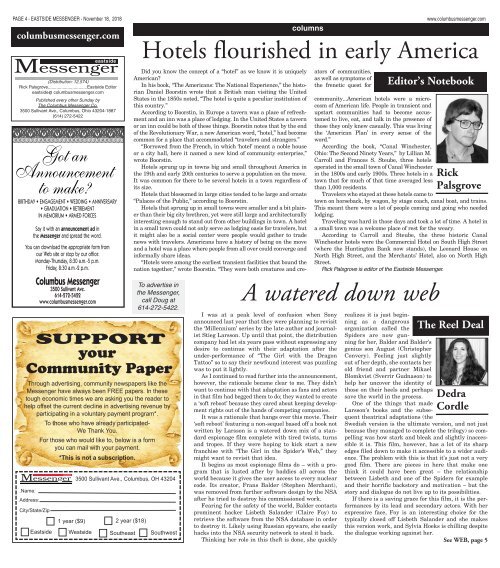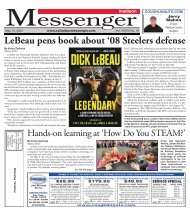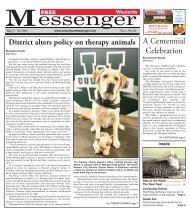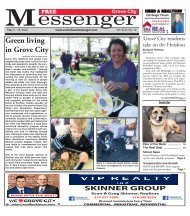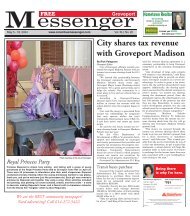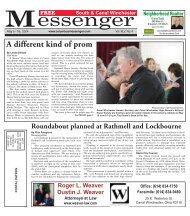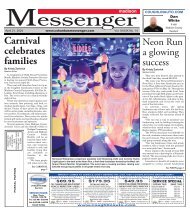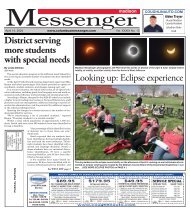Eastside Messenger - November 18, 2018
Create successful ePaper yourself
Turn your PDF publications into a flip-book with our unique Google optimized e-Paper software.
PAGE 4 - EASTSIDE MESSENGER - <strong>November</strong> <strong>18</strong>, 20<strong>18</strong><br />
columbusmessenger.com<br />
eastside<br />
<strong>Messenger</strong><br />
(Distribution: 12,574)<br />
Rick Palsgrove................................<strong>Eastside</strong> Editor<br />
eastside@ columbusmessenger.com<br />
Published every other Sunday by<br />
The Columbus <strong>Messenger</strong> Co.<br />
3500 Sullivant Ave., Columbus, Ohio 43204-<strong>18</strong>87<br />
(614) 272-5422<br />
BIRTHDAY • ENGAGEMENT • WEDDING • ANNIVERSARY<br />
• GRADUATION • RETIREMENT<br />
IN MEMORIUM • ARMED FORCES<br />
Say it with an announcement ad in<br />
the <strong>Messenger</strong> and spread the word.<br />
You can download the appropriate form from<br />
our Web site or stop by our office<br />
Monday-Thursday, 8:30 a.m.-5 p.m.<br />
Friday, 8:30 a.m.-2 p.m.<br />
Columbus <strong>Messenger</strong><br />
3500 Sullivant Ave.<br />
614-272-5422<br />
www.columbusmessenger.com<br />
SUPPORT<br />
your<br />
Community Paper<br />
Through advertising, community newspapers like the<br />
<strong>Messenger</strong> have always been FREE papers. In these<br />
tough economic times we are asking you the reader to<br />
help offset the current decline in advertising revenue by<br />
participating in a voluntary payment program*.<br />
To those who have already participated -<br />
We Thank You.<br />
For those who would like to, below is a form<br />
you can mail with your payment.<br />
*This is not a subscription.<br />
.Name:<br />
Address:<br />
City/State/Zip<br />
columbus<br />
3500 Sullivant Ave., Columbus, OH 43204<br />
1 year ($9) 2 year ($<strong>18</strong>)<br />
<strong>Eastside</strong> Westside Southwest<br />
Southeast<br />
columns<br />
www.columbusmessenger.com<br />
Hotels flourished in early America<br />
To advertise in<br />
the <strong>Messenger</strong>,<br />
call Doug at<br />
614-272-5422.<br />
Did you know the concept of a “hotel” as we know it is uniquely<br />
American?<br />
In his book, “The Americans: The National Experience,” the historian<br />
Daniel Boorstin wrote that a British man visiting the United<br />
States in the <strong>18</strong>50s noted, “The hotel is quite a peculiar institution of<br />
this country.”<br />
According to Boorstin, in Europe a tavern was a place of refreshment<br />
and an inn was a place of lodging. In the United States a tavern<br />
or an inn could be both of these things. Boorstin notes that by the end<br />
of the Revolutionary War, a new American word, “hotel,” had become<br />
common for a place that accommodated “travelers and strangers.”<br />
“Borrowed from the French, in which ‘hotel’ meant a noble house<br />
or a city hall, here it named a new kind of community enterprise,”<br />
wrote Boorstin.<br />
Hotels sprung up in towns big and small throughout America in<br />
the 19th and early 20th centuries to serve a population on the move.<br />
It was common for there to be several hotels in a town regardless of<br />
its size.<br />
Hotels that blossomed in large cities tended to be large and ornate<br />
“Palaces of the Public,” according to Boorstin.<br />
Hotels that sprung up in small towns were smaller and a bit plainer<br />
than their big city brethren, yet were still large and architecturally<br />
interesting enough to stand out from other buildings in town. A hotel<br />
in a small town could not only serve as lodging oasis for travelers, but<br />
it might also be a social center were people would gather to trade<br />
news with travelers. Americans have a history of being on the move<br />
and a hotel was a place where people from all over could converge and<br />
informally share ideas.<br />
“Hotels were among the earliest transient facilities that bound the<br />
nation together,” wrote Boorstin. “They were both creatures and creators<br />
of communities,<br />
as well as symptoms of<br />
the frenetic quest for<br />
Editor’s Notebook<br />
community...American hotels were a microcosm<br />
of American life. People in transient and<br />
upstart communities had to become accustomed<br />
to live, eat, and talk in the presence of<br />
those they only knew casually. This was living<br />
the ‘American Plan’ in every sense of the<br />
word.”<br />
According the book, “Canal Winchester,<br />
Ohio: The Second Ninety Years,” by Lillian M.<br />
Carroll and Frances S. Steube, three hotels<br />
operated in the small town of Canal Winchester<br />
in the <strong>18</strong>00s and early 1900s. Three hotels in a<br />
town that for much of that time averaged less<br />
than 1,000 residents.<br />
Travelers who stayed at these hotels came to<br />
Rick<br />
Palsgrove<br />
town on horseback, by wagon, by stage coach, canal boat, and trains.<br />
This meant there were a lot of people coming and going who needed<br />
lodging.<br />
Traveling was hard in those days and took a lot of time. A hotel in<br />
a small town was a welcome place of rest for the weary.<br />
According to Carroll and Steube, the three historic Canal<br />
Winchester hotels were the Commercial Hotel on South High Street<br />
(where the Huntington Bank now stands), the Leonard House on<br />
North High Street, and the Merchants’ Hotel, also on North High<br />
Street.<br />
Rick Palsgrove is editor of the <strong>Eastside</strong> <strong>Messenger</strong>.<br />
A watered down web<br />
I was at a peak level of confusion when Sony<br />
announced last year that they were planning to revisit<br />
the ‘Millennium’ series by the late author and journalist<br />
Stieg Larsson. Up until that point, the distribution<br />
company had let six years pass without expressing any<br />
desire to continue with their adaptation after the<br />
under-performance of “The Girl with the Dragon<br />
Tattoo” so to say their newfound interest was puzzling<br />
was to put it lightly.<br />
As I continued to read further into the announcement,<br />
however, the rationale became clear to me. They didn’t<br />
want to continue with that adaptation as fans and actors<br />
in that film had begged them to do; they wanted to create<br />
a ‘soft reboot’ because they cared about keeping development<br />
rights out of the hands of competing companies.<br />
It was a rationale that hangs over this movie. Their<br />
‘soft reboot’ featuring a non-sequel based off a book not<br />
written by Larsson is a watered down mix of a standard<br />
espionage film complete with tired twists, turns<br />
and tropes. If they were hoping to kick start a new<br />
franchise with “The Girl in the Spider’s Web,” they<br />
might want to revisit that idea.<br />
It begins as most espionage films do — with a program<br />
that is lusted after by baddies all across the<br />
world because it gives the user access to every nuclear<br />
code. Its creator, Frans Balder (Stephen Merchant),<br />
was removed from further software design by the NSA<br />
after he tried to destroy his commissioned work.<br />
Fearing for the safety of the world, Balder contacts<br />
prominent hacker Lisbeth Salander (Claire Foy) to<br />
retrieve the software from the NSA database in order<br />
to destroy it. Likely using Russian spyware, she easily<br />
hacks into the NSA security network to steal it back.<br />
Thinking her role in this theft is done, she quickly<br />
realizes it is just beginning<br />
as a dangerous<br />
organization called the<br />
Spiders are now gunning<br />
for her, Balder and Balder’s<br />
genius son August (Christopher<br />
Convery). Feeling just slightly<br />
out of her depth, she contacts her<br />
old friend and partner Mikael<br />
Blomkvist (Sverrir Gudnason) to<br />
help her uncover the identity of<br />
those on their heels and perhaps<br />
save the world in the process.<br />
One of the things that made<br />
Larsson’s books and the subsequent<br />
theatrical adaptations (the<br />
The Reel Deal<br />
Dedra<br />
Cordle<br />
Swedish version is the ultimate version, and not just<br />
because they managed to complete the trilogy) so compelling<br />
was how stark and bleak and slightly inaccessible<br />
it is. This film, however, has a lot of its sharp<br />
edges filed down to make it accessible to a wider audience.<br />
The problem with this is that it’s just not a very<br />
good film. There are pieces in here that make one<br />
think it could have been great — the relationship<br />
between Lisbeth and one of the Spiders for example<br />
and their horrific backstory and motivation — but the<br />
story and dialogue do not live up to its possibilities.<br />
If there is a saving grace for this film, it is the performances<br />
by its lead and secondary actors. With her<br />
expressive face, Foy is an interesting choice for the<br />
typically closed off Lisbeth Salander and she makes<br />
this version work, and Sylvia Hoeks is chilling despite<br />
the dialogue working against her.<br />
See WEB, page 5


